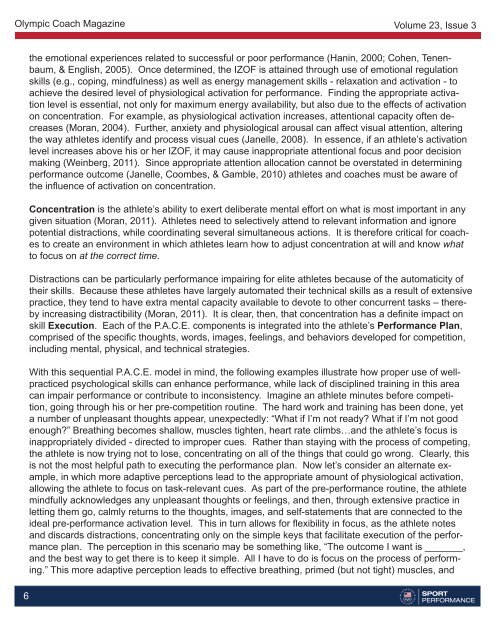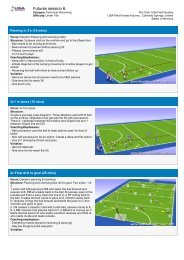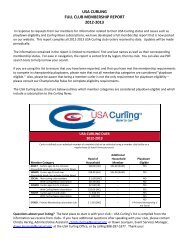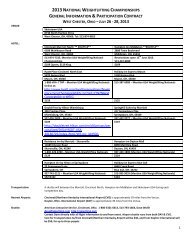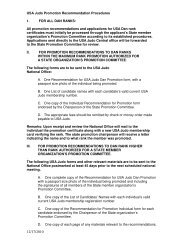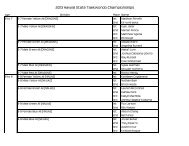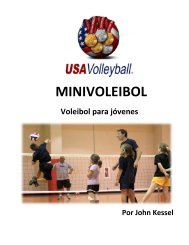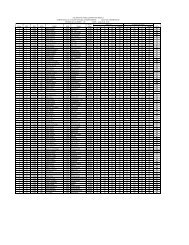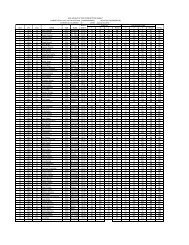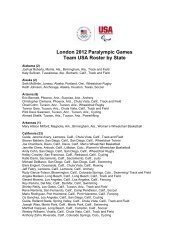OLYMPIC COACH - United States Olympic Committee
OLYMPIC COACH - United States Olympic Committee
OLYMPIC COACH - United States Olympic Committee
- TAGS
- olympic
- www.teamusa.org
You also want an ePaper? Increase the reach of your titles
YUMPU automatically turns print PDFs into web optimized ePapers that Google loves.
<strong>Olympic</strong> Coach Magazine<br />
6<br />
Volume 23, Issue 3<br />
the emotional experiences related to successful or poor performance (Hanin, 2000; Cohen, Tenenbaum,<br />
& English, 2005). Once determined, the IZOF is attained through use of emotional regulation<br />
skills (e.g., coping, mindfulness) as well as energy management skills - relaxation and activation - to<br />
achieve the desired level of physiological activation for performance. Finding the appropriate activation<br />
level is essential, not only for maximum energy availability, but also due to the effects of activation<br />
on concentration. For example, as physiological activation increases, attentional capacity often decreases<br />
(Moran, 2004). Further, anxiety and physiological arousal can affect visual attention, altering<br />
the way athletes identify and process visual cues (Janelle, 2008). In essence, if an athlete’s activation<br />
level increases above his or her IZOF, it may cause inappropriate attentional focus and poor decision<br />
making (Weinberg, 2011). Since appropriate attention allocation cannot be overstated in determining<br />
performance outcome (Janelle, Coombes, & Gamble, 2010) athletes and coaches must be aware of<br />
the influence of activation on concentration.<br />
Concentration is the athlete’s ability to exert deliberate mental effort on what is most important in any<br />
given situation (Moran, 2011). Athletes need to selectively attend to relevant information and ignore<br />
potential distractions, while coordinating several simultaneous actions. It is therefore critical for coaches<br />
to create an environment in which athletes learn how to adjust concentration at will and know what<br />
to focus on at the correct time.<br />
Distractions can be particularly performance impairing for elite athletes because of the automaticity of<br />
their skills. Because these athletes have largely automated their technical skills as a result of extensive<br />
practice, they tend to have extra mental capacity available to devote to other concurrent tasks – thereby<br />
increasing distractibility (Moran, 2011). It is clear, then, that concentration has a definite impact on<br />
skill Execution. Each of the P.A.C.E. components is integrated into the athlete’s Performance Plan,<br />
comprised of the specific thoughts, words, images, feelings, and behaviors developed for competition,<br />
including mental, physical, and technical strategies.<br />
With this sequential P.A.C.E. model in mind, the following examples illustrate how proper use of wellpracticed<br />
psychological skills can enhance performance, while lack of disciplined training in this area<br />
can impair performance or contribute to inconsistency. Imagine an athlete minutes before competition,<br />
going through his or her pre-competition routine. The hard work and training has been done, yet<br />
a number of unpleasant thoughts appear, unexpectedly: “What if I’m not ready? What if I’m not good<br />
enough?” Breathing becomes shallow, muscles tighten, heart rate climbs…and the athlete’s focus is<br />
inappropriately divided - directed to improper cues. Rather than staying with the process of competing,<br />
the athlete is now trying not to lose, concentrating on all of the things that could go wrong. Clearly, this<br />
is not the most helpful path to executing the performance plan. Now let’s consider an alternate example,<br />
in which more adaptive perceptions lead to the appropriate amount of physiological activation,<br />
allowing the athlete to focus on task-relevant cues. As part of the pre-performance routine, the athlete<br />
mindfully acknowledges any unpleasant thoughts or feelings, and then, through extensive practice in<br />
letting them go, calmly returns to the thoughts, images, and self-statements that are connected to the<br />
ideal pre-performance activation level. This in turn allows for flexibility in focus, as the athlete notes<br />
and discards distractions, concentrating only on the simple keys that facilitate execution of the performance<br />
plan. The perception in this scenario may be something like, “The outcome I want is _______,<br />
and the best way to get there is to keep it simple. All I have to do is focus on the process of performing.”<br />
This more adaptive perception leads to effective breathing, primed (but not tight) muscles, and


